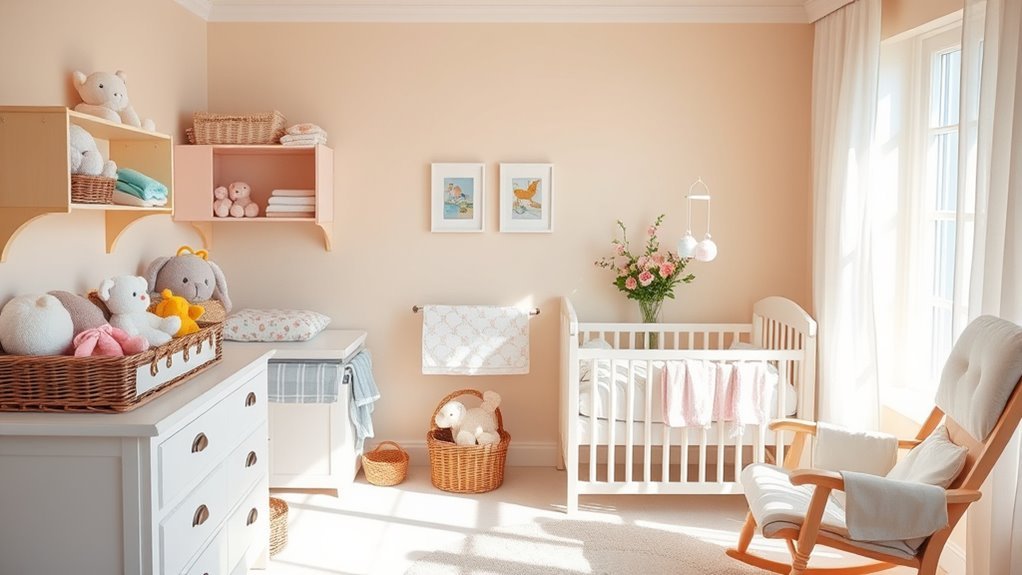Spring Cleaning Guide for Baby Items
When spring cleaning baby items, start by sorting clothes by size and condition, keeping only what’s usable. Wash toys with gentle, safe cleaners and sanitize feeding supplies thoroughly to protect your little one. Organize the nursery for easy access and maintain bedding with hypoallergenic detergents for comfort. Don’t forget to refresh diaper changing areas and properly store seasonal gear. Creating a routine helps keep everything spotless and ready. Keep going to uncover more tips for a calm, safe nursery.
Sorting and Decluttering Baby Clothes

Although sorting and decluttering baby clothes can feel overwhelming, it’s an essential step in keeping your nursery organized and safe. You’ll want to start by using effective sorting techniques: categorize items by size, season, and condition. This helps you quickly identify what’s usable and what’s not. Next, apply decluttering strategies like the “keep, donate, discard” method to make clear decisions. Remember, holding onto every cute outfit isn’t necessary; freeing up space lets you focus on what truly matters. By thoughtfully sorting and decluttering, you create a calm environment that supports your baby’s growth and your peace of mind. Embrace this process as a way to reclaim your nursery’s order and enjoy the freedom of a clutter-free space.
Washing and Sanitizing Toys
Toys are a constant companion in your baby’s daily adventures, making their cleanliness essential for health and safety. You want to guarantee toy safety while embracing eco friendly cleaning methods that protect both your child and the environment. Here’s a quick guide to washing and sanitizing toys effectively:
| Toy Type | Cleaning Method | Eco Friendly Tip |
|---|---|---|
| Plastic & Rubber | Warm soapy water, rinse | Use biodegradable soap |
| Fabric | Machine wash on gentle | Choose fragrance-free detergent |
| Wooden | Wipe with vinegar solution | Avoid harsh chemicals |
| Electronic | Spot clean with damp cloth | Use natural disinfectant wipes |
Deep Cleaning Feeding Supplies

You’ll want to make sure bottles are sterilized properly to keep germs at bay, especially after every use. Don’t forget to thoroughly clean breast pump parts, as residue can build up in hard-to-see areas. Regularly sanitizing pacifiers is also key to protecting your baby’s health.
Sterilizing Bottles Effectively
When it comes to keeping your baby’s feeding supplies safe, sterilizing bottles effectively is crucial. You want to guarantee every bottle is free from harmful bacteria without complicating your routine. Here are four reliable bottle sterilization methods using effective cleaning techniques:
- Boiling: Submerge bottles and parts in boiling water for at least five minutes.
- Steam Sterilizers: Use an electric or microwave steam sterilizer for quick, chemical-free cleaning.
- Chemical Sterilizing Solutions: Soak bottles in approved sterilizing liquids, following package instructions.
- UV Sterilizers: Utilize UV light devices that kill germs efficiently without heat or chemicals.
Choosing the right method depends on your lifestyle and baby’s needs, giving you freedom to keep feeding supplies safe with confidence.
Cleaning Breast Pump Parts
After confirming your baby bottles are thoroughly sterilized, it’s equally important to maintain the cleanliness of breast pump parts. Proper breast pump maintenance not only protects your baby’s health but also extends the life of your equipment. Stick to a cleaning schedule that fits your routine, cleaning parts after each use and deep cleaning weekly. Here’s a simple guide to keep you on track:
| Task | Frequency |
|---|---|
| Rinse parts immediately | After every use |
| Wash with warm soapy water | After every use |
| Air dry on a clean towel | After every use |
| Deep clean (boil or steam) | Weekly |
| Inspect parts for damage | Weekly |
Keeping this schedule confirms your pump parts stay hygienic and functional, giving you freedom and peace of mind.
Sanitizing Pacifiers Regularly
Anyone caring for a baby knows how important it is to keep pacifiers clean and sanitized. Regular sanitizing is key to pacifier safety and effective germ prevention, helping protect your little one from harmful bacteria. To maintain this essential hygiene, follow these steps:
- Wash pacifiers with warm, soapy water after each use.
- Boil them for 5 minutes or use a steam sterilizer regularly.
- Inspect pacifiers for damage or wear, replacing them as needed.
- Store pacifiers in a clean, dry container to avoid contamination.
Organizing the Nursery Space

Although organizing the nursery space might feel overwhelming, creating a functional and tidy environment is essential for both you and your baby’s comfort. Start by evaluating your nursery layout—ensure it maximizes safety and accessibility. Position frequently used items within easy reach to save time and reduce stress. Invest in smart storage solutions like wall-mounted shelves, bins, and multi-purpose furniture to keep toys, clothes, and diapers neatly arranged. Labeling storage areas can help you maintain order effortlessly. Remember, a streamlined nursery allows you more freedom to enjoy precious moments with your baby without clutter distractions. By thoughtfully organizing your nursery space now, you’re setting the stage for a calmer, more efficient daily routine that supports both your needs and your little one’s development.
Maintaining Baby Bedding and Blankets
You’ll want to wash baby bedding and blankets at least once a week to keep them fresh and safe. Choosing gentle, hypoallergenic cleaning products is key to protecting your baby’s sensitive skin. Let’s explore simple tips to maintain these essentials without causing irritation.
Washing Frequency Tips
Regularly washing your baby’s bedding and blankets is essential to keep their sleeping environment clean and safe. Knowing the right washing frequency prevents buildup of allergens and bacteria while preserving fabric quality. Different fabric types, like cotton or fleece, require specific care routines. Here’s a practical approach:
- Weekly Washing: For sheets and pillowcases, especially if your baby has sensitive skin or allergies.
- Biweekly for Blankets: Unless visibly soiled, this prevents wear from over-washing.
- Spot Clean Delicate Fabrics: Use gentle methods for wool or specialty blankets to maintain softness.
- After Illness or Spills: Increase washing frequency to reduce germ exposure and odors.
Safe Cleaning Products
When selecting cleaning products for your baby’s bedding and blankets, it is crucial to choose ones that are both effective and gentle. You want to protect your little one’s sensitive skin while ensuring a hygienic environment. Opt for eco friendly cleaners that use plant-based ingredients free from harsh chemicals, dyes, and fragrances. These products minimize exposure to toxins and reduce environmental impact, giving you peace of mind. Natural disinfectants like white vinegar or baking soda provide safe, non-toxic ways to eliminate germs without compromising softness. Avoid bleach or strong synthetic detergents, which can irritate delicate skin and damage fabric fibers. By choosing these safer options, you’re not only maintaining cleanliness but also supporting your baby’s health and your family’s freedom to live worry-free in a cleaner, safer space.
Cleaning and Inspecting Baby Gear
Although baby gear is designed to withstand daily use, it still needs thorough cleaning and inspection to confirm your little one’s safety and comfort. Regular maintenance not only keeps items hygienic but also guarantees you catch any wear or damage early. When you tackle this task, focus on these key steps:
- Clean surfaces with baby-safe products, avoiding harsh chemicals.
- Inspect straps, buckles, and joints for wear or damage.
- Test moving parts like wheels or hinges to guarantee smooth operation.
- Check for recalls or safety alerts related to your gear model.
Refreshing Diaper Changing Areas
Since diaper changing is a frequent part of your daily routine, keeping the area clean and organized is vital for both hygiene and convenience. Start by thoroughly cleaning the changing pad; use gentle, baby-safe disinfectants to maintain changing pad hygiene and prevent germs. Next, assess your diaper supplies organization—group diapers, wipes, creams, and hand sanitizer in clearly labeled containers or baskets. This setup not only saves time but also reduces stress during those quick changes. Regularly declutter the space by removing expired products and restocking essentials. A tidy, sanitized changing area helps you feel more in control and guarantees your baby’s comfort and safety. Revitalizing this space is a small effort that offers you freedom from chaos and peace of mind every day.
Storing Seasonal Baby Items
Keeping your diaper changing area clean and organized sets a great foundation for managing other baby items, especially those used seasonally. When it comes to seasonal storage, you want a system that’s simple and effective, allowing easy item rotation as the weather changes. Here’s how you can streamline this:
- Use clear bins labeled by season to quickly identify stored items.
- Store out-of-season clothes and gear in a cool, dry place to preserve quality.
- Rotate items monthly to guarantee nothing gets forgotten or damaged.
- Donate or discard items your baby has outgrown before storing new seasonal gear.
Creating a Maintenance Routine for Baby Items
When you establish a consistent maintenance routine for your baby’s items, you’ll save time and reduce stress in the long run. Start by creating a maintenance checklist that covers daily, weekly, and monthly tasks—like sanitizing bottles, washing toys, and inspecting gear for wear. Set a routine schedule that fits your lifestyle, so these tasks become second nature rather than overwhelming chores. Staying proactive helps you keep everything safe, clean, and ready for use, giving you more freedom to enjoy quality moments with your little one. Remember, a well-maintained baby environment isn’t just about cleanliness; it’s about peace of mind and freeing yourself from last-minute scrambles. Your maintenance checklist and routine schedule are your best tools for lasting order and ease.
Häufig gestellte Fragen
How Often Should I Replace My Baby’s Pacifiers?
You should replace your baby’s pacifiers regularly to guarantee safety and hygiene. Typically, a pacifier lifespan is around one to two months with frequent use. Keep an eye out for replacement signs like cracks, discoloration, or sticky residue. Damaged pacifiers can pose choking hazards, so don’t wait too long. Staying vigilant helps you give your baby freedom to soothe themselves safely and keeps your peace of mind intact.
Are There Natural Cleaning Products Safe for Baby Items?
When wondering about natural cleaning products, rest assured, you can safely sanitize your baby’s belongings without harsh chemicals. Gentle, green cleaners like diluted white vinegar or baking soda offer effective, eco-friendly solutions that prioritize baby safety. You don’t have to compromise on cleanliness or your values—these natural options cleanse thoroughly while keeping toxins at bay, granting you freedom to nurture your little one in a safe, healthy environment.
Can I Use a Dishwasher to Clean Baby Bottles?
You can definitely use a dishwasher for baby bottles, but you’ll want to check the dishwasher safety of each item first. Many bottles are designed to withstand dishwasher heat, making cleaning easier for you. However, dishwasher cleaning doesn’t always guarantee complete bottle sterilization, so consider using a sterilizer occasionally to eliminate stubborn bacteria. This combo gives you freedom from constant scrubbing while keeping your baby’s feeding gear hygienic and safe.
How Do I Safely Dispose of Expired Baby Formula?
Did you know that over 30% of household waste is food-related? When it comes to expired formula disposal, you want safe disposal methods that protect your family and the environment. Don’t just toss it in the trash; mix the expired formula with something unappealing, like used coffee grounds, to prevent animals from consuming it. Seal it in a sturdy bag before discarding. This way, you’re responsibly freeing yourself from waste without harm.
What Is the Best Way to Clean Cloth Diapers?
When cleaning cloth diapers, you want to use effective diaper sanitization methods to keep your baby safe. Start by rinsing solids off, then wash in hot water with a gentle detergent. Avoid fabric softeners as they reduce absorbency. For cloth diaper storage, keep them in a dry, breathable container until wash day to prevent odors and mold. This way, you’ll feel confident and free knowing your diapers are clean and sanitized properly.






